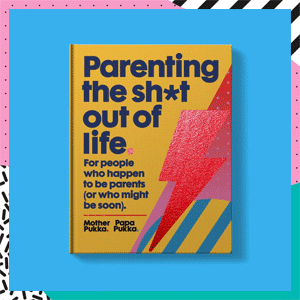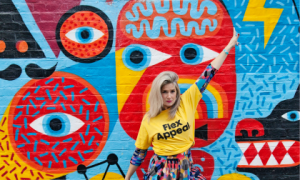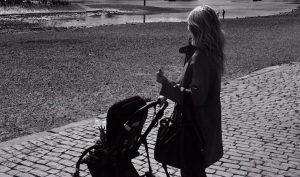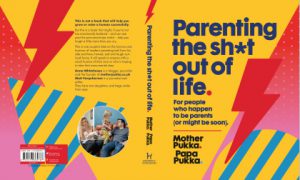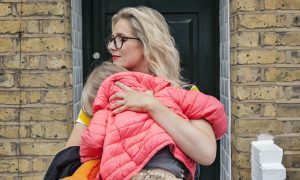

I’ve just uploaded a photo of myself nuzzling my 10-month-old daughter to Instagram where I have 159,000 followers. In terms of cracking open a discussion on child online safety – and later, teenage online safety – I’m not coming to the digital party from a position of strength. It’s on par with The Cookie Monster analysing the negative impact of sugar in our diets.
This is certainly no self-flagellation exercise, though. It’s more an opportunity to lift the slightly sticky lid on the cookie jar; to rifle around among the crumbs lurking at the bottom and see what we are, in fact, doing here. On the Internet, online, uploading the good, bad and increasingly ugly (and not-so-ugly if you follow @symmetrybreakfast) elements of our existence. And to see how this digital drive is impacting – or might impact in the future – those we are nuzzling.
I don’t have the answers. But I’ve been digging deep for some guidance in a pixellated world that has been described as the ‘Wild West’; a world where the surface is seemingly peony-embellished and the underbelly a murky wasteland of uncertainty, confusion and muddy digital footprints.
To sharent or not to sharent?
“There are two things to be careful about,” says Victoria Nash, acting director of the Oxford Internet Institute when it comes to uploading an image of your kids. “One is the amount of information that you give away, which might include things like date of birth, place of birth, the child’s full name, or tagging of any photographs with a geographical location – anything that could be used by somebody who wanted to steal your child’s identity.
“The second issue is more around consent. What type of information would children want to see about themselves online at a later date?”
Regardless of whether you privately have 32 followers or publicly have 320,000, Sonia Livingstone, professor of social psychology at the London School of Economics, and an expert on children and the Internet urges us to take a moment to consider the nature of what we are about to foghorn to the world. “I think we should start with the question of cost – if you post a picture of your child with the mark of the devil on their arm, or in a temper tantrum, perhaps that will have a future cost. It’s not all pictures, but certain pictures that are problematic.”
It’s the equivalent of posting something juvenile and abrasive as a teen on Twitter and then – on becoming a fan-girled member of One Direction – that childish 140-character blurb defines who you are as it’s amplified on the front page of The Sun.
One friend (we shall call her Hyacinth for suitably protective purposes) uses a pet name for her daughter online instead of her real name. This is one simple step we can all adopt to reduce our children’s digital footprint. “Unless you literally post nothing at all, there is no perfect protection. But most parents probably find a happy medium, which is posting pictures or stories about their young children either without using their real name or without tagging them in pictures,” adds Livingstone.
By using a pet name, Hyacinth has also offered up some protection against those lurking companies or individuals who might be interested in her daughter’s personal data; even if Hyacinth’s privacy settings let her down, a search for her real name would not bring up any of her posts – at least for now.
From a personal perspective, we started out using ‘The Urchin’ when I launched Mother Pukka, then moved towards ‘Squidge’ when ‘The Urchin’ seemed a little Dickensian – and, perhaps, something that she would not have looked back on fondly – and have thrown in ‘Stevie’ for good measure. But this process has not been watertight and our daughter’s names are known, so we’ve started using emojis to represent them (to eradicate any searchable terms) or, rather perfunctorily, ‘my eldest’ and ‘my youngest’. Again, this is not a ‘you should do this exercise’; more a ‘this is where we are at’ gathering of words.
“It is increasingly difficult to secure anonymity online,” says Amy Webb, a futurist and CEO of digital strategy firm Webb.
Privacy settings are simple and, yet, not watertight. Unless you don’t touch the Internet, your footprint – regardless of whether you have tapped ‘private’ or not on Instagram – will be embedded there. Even Webb (who uploaded nothing of her children and has a private account) found herself caught out; in the process of trying to integrate her many social network and digital accounts, a couple of baby photos that she had edited using Instagram’s mobile editing tool somehow became public.
She never would have known, except that after writing about digital anonymity in Slate, several readers delved deep and found those photos with a subtext of “we’ve got you”.
(So not to scaremonger but even my Aunty June who has a hint of moral superiority in her tone when speaking about THE INTERNET – because she has her privacy settings locked down – is not fully ‘safe’ here.)
I think that’s a relevant point to highlight, though: it’s one thing expressing a concern about someone’s online security (“If I was you I’d be worried that your family could be found by a loon because you’ve posted X, Y and Z”) and a whole different moral ballgame posting the address to prove a point. (“Well look, I’ve found you [published on a public forum with 12 million visitors] so others can.”) In these increasingly murky realms with little or no policing, there has to be an unwritten moral code of conduct not to endanger further – regardless of personal gripes with a person. Vindictive is never a go-to state online or offline.
Back to the cost element – that cost of calling your child a ‘twat’ for not eating their broccoli, perhaps or detailing the contents of their nappy for the world to laugh at. Or, on a less obvious level, penning something personal about miscarriage (which I write extensively on) in the hope of making people suffering feel less alone. What should we be considering? What will it mean for our relationships with those we are currently waving a Fisher Price BeatBop toy at?
“Ten years from now, almost all the next generation of teenagers will all have baby photos on social media; it’s not going to be something that stigmatises them,” says Nash.
“My guess is that it will magnify whatever relationship they already have with their parents. If they have a great relationship, they may look back on those photos and say, ‘Wow, I can appreciate what my mum went through.’ However, if they are upset with their parents they may view such posts as this infringement of their privacy, and use them as fuel to the fire.”
Whenever I’ve been asked what my steps are in protecting ‘Squidge’ and ‘Stevie’ online, I cannot say they are watertight. And that possibly makes me a bad person and open to significant judgment. But these are our current personal – and I still believe like with the majority of parenting choices it is personal – online safety measures:
- Never using their names (this has been since November 2016)
- Never revealing school address or uniform
- Considering how they would feel reading the caption and seeing the image in ten years time
- Considering what others – potential bullies – might see as ammunition in the image and caption
- Restricting images of them to 1 in 5 (hence the many graphic-led, less engagement-worthy tiles on my feed)
- Ensuring as much as possible their faces are not in full view
- Ensuring no bathtime or swimming suit or naked images are used
- Using a black and white filter where possible – according to the NSPCC, predators seek clear colour images
- Ensuring images uploaded of them have no space behind them to superimpose anything or anyone
- Ensuring I have a ‘content’ structure and some control over what I’m uploading day-to-day so I’m not taking photos ‘in the moment’ for fear of ‘missing the moment’. Hence why I work with the photographer Charlotte Emily Gray – so we have one day a month where we take images, meaning the rest of the month isn’t spent with my phone in their grill. From a purely brand perspective, it’s not good for engagement to not be posting ‘in the moment’ but it’s one step towards controlling this all-consuming business – and business it is. Plus I am a shambolic photographer
- To realise the above needs constant adjustment and those discussions need to include the whole family. My eldest is now in school and so it doesn’t feel right including her in videos or on my feed any more. If she is there, it’s an arm around my neck here or an obscured photo there
- Not to judge or scaremonger anyone else, just to inform
- To keep up-to-date on online child safety developments on the NSPCC website
One thing that truly hit home for me, though, was when Mark Zuckerberg was recently asked by the Supreme Court this simple question: “What hotel are you staying at?” Zuckerberg laughed and replied: “I’m not telling you. I can’t see how that is relevant”. And, yet, he has built a billion dollar business on encouraging us to tell everyone else where we are, what we are doing – and, perhaps, more worryingly, where our children are and what they are doing. Even if it seems irrelevant.
Regardless of how much I love social media and see the positives of uniting on a mass scale, this ever-changing realm shouldn’t go unquestioned.
Of 159,000 people following me, how do I know who is actually out there? What proportion of people wish me well? What about the – hopefully small – segment who are hate following? Those who seek to translate the hate into something more sinister offline? Who knows? And is that vagueness a significant concern as a parent?
Food – specifically cookies – for thought, indeed.
Text, sext and what’s next?
One of the main things that sparked this blog post was the health secretary Jeremy Hunt lampooning social media companies last week for “turning a blind eye” to emotional problems and mental health damage suffered by children who have free reign of the Internet. While I am not about to give the man a bosomy hug – and certainly don’t want to align myself with his political viewpoint, the man does – regardless of his often shady intentions – raise a solid point.
My own deep-rooted fear of my daughters running this pixellated gauntlet stems from an explicit message I received from a 14-year-old boy last year. The police were involved and his parents informed – but a lurking queasiness and innate fear of the accessibility of this newfound platfrom has remained with me ever since. Speaking to safeguarding expert Victoria Leather, who has worked in safeguarding in the public sector her whole life, it became clear that I could have also been charged had I responded in any way. While I don’t want this to be a scaremongering exercise, the consequences of our/my actions – however well meaning – are there to be used against us at any given moment.
“There is a lot of evidence that the technology industry, if they put their mind to it, can do really smart things,” said Hunt last week. “For example, I ask myself the simple question as to why you can’t prevent the texting of sexually explicit images by people under the age of 18, if that’s a lock that parents choose to put on a mobile phone contract.” He added: “There is technology that can identify sexually explicit pictures and prevent [them] being transmitted.”
Hunt’s letter (to giants like Apple and Zuckerberg) continued: “I fear that you are collectively turning a blind eye to a whole generation of children being exposed to the harmful emotional side-effects of social media prematurely; this is both morally wrong and deeply unfair on parents, who are faced with the invidious choice of allowing children to use platforms they are too young to access, or excluding them from social interaction that often the majority of their peers are engaging in. It is unacceptable and irresponsible for you to put parents in this position.”
Rates of stress, anxiety and depression were rising particularly sharply among teenage girls. NHS data showed that the number of times a girl aged 17 or under has been admitted to hospital in England because of self-harm had jumped from 10,500 to more than 17,500 a year over the previous decade – a rise of 68%. The rise among boys was much lower at 26%.
He also said at the time that technology should be used to tackle cyberbullying automatically, using “word-pattern recognition”. There were many areas “where social media companies could put options in their software that could reduce the risks associated with social media”, he added.
But in the interim – an interim where we/I have not got a answers in this ever-shape-shifting world – here are a few varying thoughts from those a little more in the know:
‘Start discussing online safety at an early age’
David Emm, senior security researcher at internet security company Kaspersky Lab
“I think one of the key things is to start the process of discussing online safety with your children at an early age, when they start to do anything that involves the Internet.
They might still be using the computer with you, rather than independently and this offers an opportunity to highlight the fact that the online world parallels the real world and that there are both safe and unsafe things out there. It also enables you to discuss the things that are there to protect us, e.g. Internet security protection, passwords, etc.
As they get older and begin to do things independently, widen the circle. For example, if you let them start an account with Club Penguin or Moshi Monsters, help them create a sensible password and explain why they should use different passwords for each account and the possible consequences of not doing so.”
‘If you wouldn’t do it face to face – Don’t do it online’
Shelagh McManus, online safety advocate for security software Norton by Symantec
“The advice I give my own family and friends is encapsulated in: “If you wouldn’t do it face to face – Don’t do it online” For example, would you go up to a complete stranger and start a conversation? Would you be abusive to friends or strangers in a pub or bar?
Just because you feel protected by the apparent distance a screen gives between you and the person you’re talking to, you must remember that online is still the real world.
Mid to late teens need to remember that everything they do over the web is captured forever and could come back to haunt them. Many employers and university admissions offices look at social media profiles when researching candidates.
My husband and I actually used to ask random questions based on what the younger family members had put online just to remind them that they should lock down their profiles! If they didn’t want their dad, uncles and aunts or future employers asking about exactly what was in that fifteenth drink on Saturday night, they needed to check their privacy settings!”
‘At least I don’t feel like a spy…’
Paul Vlissidis, technical director at cyber security firm NCC Group
“My view is very non-PC I’m afraid (no pun intended). I have no filtering of any kind on my kids internet, no snooping and no time limits. I have of course spoken to each of them about the perils of the internet and they know that it’s an unsafe place unless they stay on the mainstream sites.
They do have AV [antivirus software] and I do scan their machines regularly for malware and ensure they remain fully patched but that’s it. Basically I trust them.
They have approached me several times where something odd has happened or where they had concerns (one Google search my daughter did for Barbie and Ken certainly produced some interesting results I recall). Of course they may yet turn out to be axe murderers, but only time will tell and at least I don’t feel like a spy.”
‘Teach them to beware of strangers bearing gifts’
Amichai Shulman, CTO of network security firm Imperva
“Being a parent (four children), paranoid and a vendor I can shed some light on this. My basic belief is that adults have proven once and again vulnerable to cyber attacks and therefore we cannot expect children to be any better – especially given that their sense of curiosity is far more developed and their sense of caution far less mature.
I do not expect my children to behave online much different than in the real world and therefore I explain to them about hackers being a type of criminal that breaks into your house through the computer rather than through the window. It’s easy for them to understand it.
I also teach them to beware of strangers bearing gifts much like they should in the physical world. For example, I don’t allow my children to open a mail package if they don’t KNOW who sent it (or got my permission to do so) – much the same way, I don’t allow them to open unsolicited email attachments.
Could they fall prey to someone who took over their friend’s account and sent out malware? Yes, but so would most adults. Could they fall prey to a targeted attack on our family? They probably will – like almost all adults.”
‘Once you’ve written something you can’t delete it’
David Robinson, chief security officer at Fujitsu UK & Ireland
“The Internet is a fantastic place, but you have to be careful what you do and say when you are there. Don’t say things which you wouldn’t talk about in conversations with your family, think about what you do and say, you may well regret what you do by hurting someone or being hurt yourself.
Remember once you’ve written something you can’t delete it, despite what Google are doing in Europe, the right to be forgotten doesn’t apply everywhere! If what you do or say is controversial it will be copied many times and will always come back and bite you, even in later life when you apply to go to college, university or even a job.
How you connect is important too, the gadgets you use, smart phones, tablets even old fashioned computers all need to be protected as well. But that’s only one part of it, those applications and services you use need to be protected, you don’t want others seeing your information. Use sensible passwords and protection, it’s a little price to pay for the security of your information and intimate details.
Don’t be frightened to ask for help either, there’s lots of places and people who can show you what to do and how to behave such as Get Safe On-line, friends and teachers.”
‘Never, under any circumstances, browse unaccompanied’
Dave King, chief executive of online reputation management company Digitalis
“The first and most fundamental principle is that my children never, under any circumstances, browse unaccompanied. They both have iPad Mini devices at which they are more adept than most adults I know. But both devices are set to forget the wifi access code so that they cannot get online without either my wife or I present.
Ditto the computers in the house and the main screen for the computers to which they have access is in our living space (not bedrooms) so that any activity is plain to see.
We talk to the children about the risks because the time will come that they have access outside the safety of our home. We make a point of being open about the concept of inappropriate content and the existence of bad people. In the same way that a generation ago we were told to shout loud when approached by a stranger, we tell the girls to tell us immediately of any approach online.
We talk about trolling as we talk about bullying and we talk about paedophiles in the virtual and real world. Ultimately we want to retain their innocence but where we used to want street-wise kids we now need web-wise children.”
‘Try and be vigilant and monitor what you can’
Chase Cunningham, lead threat intelligence agent for cloud security company Firehost – and creator of educational comic The Cynja
“For my kids I have already set them up with their own personal private clouds through the Respect Network and I have set up all the devices that they can or could access the internet with has a passcode that only I know and each device has blocks on sites that I consider risky.
I also have set up monitoring on their credit reports (yes they are only three and five but kids credit thievery happens all the time) and I am with them when they are using the internet.
I tried to explain to them about the nasty side of the internet but it kind of fell on deaf ears, but I was able to educate them about the dangers of the internet through my comic The Cynja.
They didn’t understand what I meant when I talked about malware and botnets as a tech geek dad but they understood that bad things are out there in cyberspace when they read the comic and saw the images.
For me, and quite a few other parents recently, that was a real connection point for the kids was when they had a comic character to relate to who is literally telling them about being safe online and protecting their digital selves, they understood the story and were getting the message of being safe online all at the same time.”
The Cynja is a comic that teaches children about cybersecurity.
‘Educate early and often’
Samantha Humphries-Swift, product manager at cybersecurity firm McAfee Labs
“Get involved – I speak with my daughter regularly about which sites she is using, and given her age, I personally vet all app downloads. This way, I can keep an eye on security settings and make a judgement on whether I think it’s safe and appropriate for her to use.
Educate early and often – I warned my daughter about the dangers of the internet as soon as she started browsing, and remind her of safe online behaviour regularly – don’t accept friendship requests from people you don’t know, verify requests if they look to be coming from someone you do know, never agree to a private chat with a stranger, never post your mobile phone number or home address online for all to see.
Communication is key – I like to be open, approachable and understanding about what my daughter is getting up to online. This way it makes it easier for her to come to me with any problems she’s experiencing online, and she’s happy to ask for advice.
On a more general note, talk to your kids about how they use their computers and smartphones and ask about any concerns they might have. Be prepared to field any questions they may ask – there are plenty of online resources available to help support you in answering tough and delicate questions.”
‘Not just to tell them the rules but also to spend the time’
Jesper Kråkhede, senior information security consultant at IT security company Sentor
“My first observation on keeping your kids safe online is not just to tell them the rules but also to spend the time to show them that you’re the most trustworthy when it comes to the internet. In brief, a good line of communication with your kids, where they can talk to you and you to them is THE starting point for the best online protection.
When it comes to passwords I tell them to use long sentences. Easy for them to remember and hard for others to crack. I teach them how to check that the virus protection is updated and how to answer requests. The bottom line we’ve agreed is that if they are unsure they should ask me.
My kids use Facebook, Instagram, Twitter etc and I have asked them to be-friend me on all their apps. The next piece of advice I’ve given them is if they are posting a picture or a comment and they think they wouldn’t want me as their Dad to see it, then it doesn’t belong in the public domain at all.”
‘Become friends and contacts in your child’s social media’
Tracy Hulver, senior identity specialist for telco firm Verizon
“Make sure your children ONLY message and accept friend and contact requests from people they know. A lot of times the number of contacts of friends you have become a “popularity contest”. People that do not have appropriate of good intentions realize that and will try and contact kids by masking as people they are not and “infiltrating” the child’s “inner circle”.
Make sure YOU as a parent, become friends and contacts within your child’s social media circles and ensure you monitor posts. Your children may resist but tell them that is one of the conditions for you to allow them access.
Ask to see their child mobile devices periodically. Some children, especially the older they get, will not want Mom and Dad looking at their messages to their friends and that’s OK if the parent doesn’t want to do that.
But if nothing else, look to see what apps are installed, take a mental inventory, and if the parent is not familiar with the app, go online and do investigation. That way you at least know the types of social media services your child is using and to the point earlier, you should at least sign up for that service to see what it’s all about.”
‘Imagine a responsible adult standing behind them’
Kevin Gourlay, head of technical assurance at Platinum Squared, and head of the (ISC)2 Safe and Secure Online cybersafety initiative
“My general rule is If they can imagine a responsible adult standing behind them, and watching what they are doing on the Internet, and they would be happy with being watched by them, then what they are doing is ok.
If they are on Twitter for example, or Facebook, commenting or replying to posts, If they think that I would be OK with them doing what they are doing, then it’s ok. They need to be helped to apply common sense, rather than told what to do, and this can be easy for children once you help them to understand the risks.
My two children are 9 and 14 years old, so I have two different sets of rules and advice for them. For my youngest, I’ll teach her about the websites that are likely to be safe online: .co.uk, .edu, .org, etc., and I have a whitelist in place to make sure she only stays on those sites.
However, as they get older, learn more and become more mature, that list grows out and it becomes more of a blacklist with just certain websites blocked. It’s about giving them more freedom as they get more mature.”
‘It’s about them understanding simple safety rules’
Lucy Woodward, director at Disney’s Club Penguin virtual world for children
“This is the crunch generation – so it’s vital that we get it right, and kids and parents learn internet safety skills for themselves. My kids are still very young so for me it’s about them understanding simple safety rules at this stage and keeping it fun – for example understanding what a password is and keeping it secret (kids love secrets!).
At school my daughter has an Internet reading program where she has an individual password and I have found this a good way in to talking about the issue. My children like many will be straight on the internet at any given opportunity so I also encourage them to tell me if they click on something that they don’t like the look of so they get in to an early routine of doing this and always knowing they can talk to us.”
Talk the talk
Speaking further to Victoria Leather, she recommends parents stay up-to-date on how to keep their children safe, with the help of the NSPCC website (link below). “Safe, stable and nurturing relationships between parents and children are the starting points for protecting children offline and online,” she says. “These foundations make it easier to talk about difficult topics in age appropriate ways throughout childhood. Informed parents who keep up to date with the challenges faced by their children, whatever their age, are better placed to make informed, proportionate responses to risk.” CEOP and ThinkUKnow are also great sources of information in supporting parents and children by delivering online education and raising awareness of online child sexual exploitation. They also have information for supporting children with special educational needs and disabilities.
Here are some useful links if you would like to get fully genned up:
Stalking and Harassment Legal Guidance from Crown Prosecution Service
Note: If you would like to comment on this blog post or kick-start a discussion, please use my latest Instagram post. I would be keen to see where you are at and what I might be missing. We are, after all, in this together. From one Cookie Monster to, perhaps, another.



